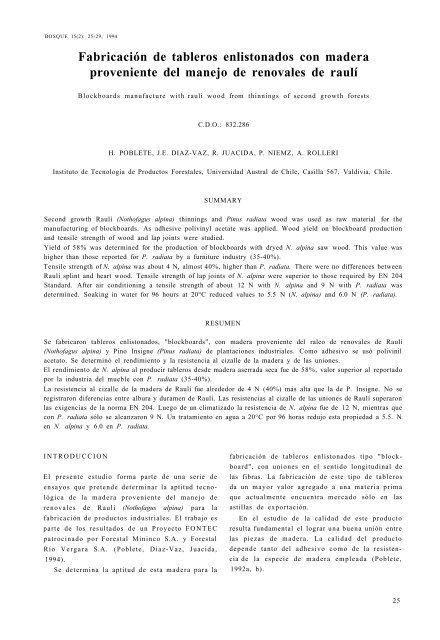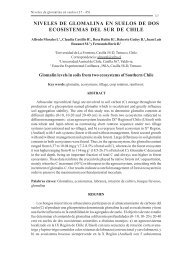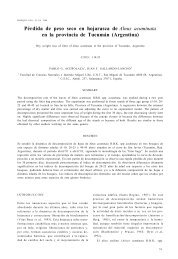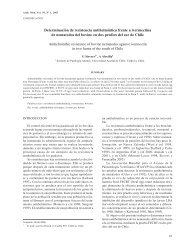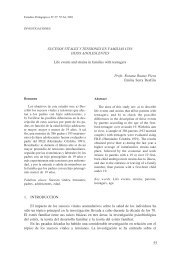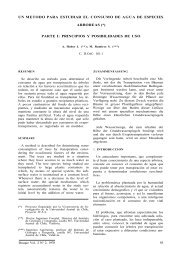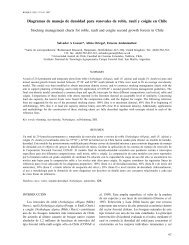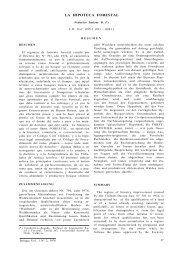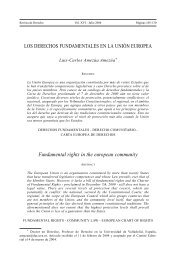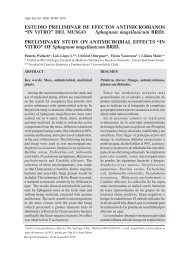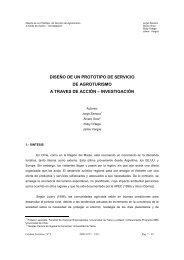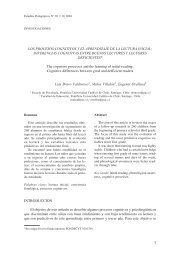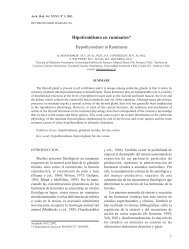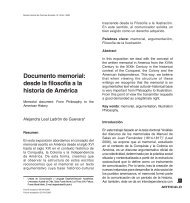Fabricación de tableros enlistonados con madera proveniente del ...
Fabricación de tableros enlistonados con madera proveniente del ...
Fabricación de tableros enlistonados con madera proveniente del ...
You also want an ePaper? Increase the reach of your titles
YUMPU automatically turns print PDFs into web optimized ePapers that Google loves.
BOSQUE 15(2): 25-29, 1994<br />
<strong>Fabricación</strong> <strong>de</strong> <strong>tableros</strong> <strong>enlistonados</strong> <strong>con</strong> ma<strong>de</strong>ra<br />
<strong>proveniente</strong> <strong>de</strong>l manejo <strong>de</strong> renovales <strong>de</strong> raulí<br />
Blockboards manufacture with rauli wood from thinnings of se<strong>con</strong>d growth forests<br />
C.D.O.: 832.286<br />
H. POBLETE, J.E. DIAZ-VAZ, R. JUACIDA, P. NIEMZ, A. ROLLERI<br />
Instituto <strong>de</strong> Tecnología <strong>de</strong> Productos Forestales, Universidad Austral <strong>de</strong> Chile, Casilla 567, Valdivia, Chile.<br />
SUMMARY<br />
Se<strong>con</strong>d growth Raulí (Nothofagus alpina) thinnings and Pinus radiata wood was used as raw material for the<br />
manufacturing of blockboards. As adhesive polivinyl acetate was applied. Wood yield on blockboard production<br />
and tensile strength of wood and lap joints were studied.<br />
Yield of 58% was <strong>de</strong>termined for the production of blockboards with dryed N. alpina saw wood. This value was<br />
higher than those reported for P. radiata by a furniture industry (35-40%).<br />
Tensile strength of N. alpina was about 4 N, almost 40%, higher than P. radiata. There were no differences between<br />
Raulí splint and heart wood. Tensile strength of lap joints of N. alpina were superior to those required by EN 204<br />
Standard. After air <strong>con</strong>ditioning a tensile strength of about 12 N with N. alpina and 9 N with P. radiata was<br />
<strong>de</strong>termined. Soaking in water for 96 hours at 20°C reduced values to 5.5 N (N. alpina) and 6.0 N (P. radiata).<br />
RESUMEN<br />
Se fabricaron <strong>tableros</strong> <strong>enlistonados</strong>, "blockboards", <strong>con</strong> ma<strong>de</strong>ra <strong>proveniente</strong> <strong>de</strong>l raleo <strong>de</strong> renovales <strong>de</strong> Raulí<br />
(Nothofagus alpina) y Pino Insigne (Pinus radiata) <strong>de</strong> plantaciones industriales. Como adhesivo se usó polivinil<br />
acetato. Se <strong>de</strong>terminó el rendimiento y la resistencia al cizalle <strong>de</strong> la ma<strong>de</strong>ra y <strong>de</strong> las uniones.<br />
El rendimiento <strong>de</strong> N. alpina al producir <strong>tableros</strong> <strong>de</strong>s<strong>de</strong> ma<strong>de</strong>ra aserrada seca fue <strong>de</strong> 58%, valor superior al reportado<br />
por la industria <strong>de</strong>l mueble <strong>con</strong> P. radiata (35-40%).<br />
La resistencia al cizalle <strong>de</strong> la ma<strong>de</strong>ra <strong>de</strong> Raulí fue alre<strong>de</strong>dor <strong>de</strong> 4 N (40%) más alta que la <strong>de</strong> P. Insigne. No se<br />
registraron diferencias entre albura y duramen <strong>de</strong> Raulí. Las resistencias al cizalle <strong>de</strong> las uniones <strong>de</strong> Raulí superaron<br />
las exigencias <strong>de</strong> la norma EN 204. Luego <strong>de</strong> un climatizado la resistencia <strong>de</strong> N. alpina fue <strong>de</strong> 12 N, mientras que<br />
<strong>con</strong> P. radiata sólo se alcanzaron 9 N. Un tratamiento en agua a 20°C por 96 horas redujo esta propiedad a 5.5. N<br />
en N. alpina y 6.0 en P. radiata.<br />
INTRODUCCION fabricación <strong>de</strong> <strong>tableros</strong> <strong>enlistonados</strong> tipo "blockboard",<br />
<strong>con</strong> uniones en el sentido longitudinal <strong>de</strong><br />
El presente estudio forma parte <strong>de</strong> una serie <strong>de</strong> las fibras. La fabricación <strong>de</strong> este tipo <strong>de</strong> <strong>tableros</strong><br />
ensayos que preten<strong>de</strong> <strong>de</strong>terminar la aptitud tecno da un mayor valor agregado a una materia prima<br />
lógica <strong>de</strong> la ma<strong>de</strong>ra <strong>proveniente</strong> <strong>de</strong>l manejo <strong>de</strong> que actualmente encuentra mercado sólo en las<br />
renovales <strong>de</strong> Raulí (Nothofagus alpina) para la astillas <strong>de</strong> exportación.<br />
fabricación <strong>de</strong> productos industriales. El trabajo es En el estudio <strong>de</strong> la calidad <strong>de</strong> este producto<br />
parte <strong>de</strong> los resultados <strong>de</strong> un Proyecto FONTEC resulta fundamental el lograr una buena unión entre<br />
patrocinado por Forestal Mininco S.A. y Forestal las piezas <strong>de</strong> ma<strong>de</strong>ra. La calidad <strong>de</strong>l producto<br />
Río Vergara S.A. (Poblete, Díaz-Vaz, Juacida, <strong>de</strong>pen<strong>de</strong> tanto <strong>de</strong>l adhesivo como <strong>de</strong> la resisten<br />
1994). cia <strong>de</strong> la especie <strong>de</strong> ma<strong>de</strong>ra empleada (Poblete,<br />
Se <strong>de</strong>termina la aptitud <strong>de</strong> esta ma<strong>de</strong>ra para la 1992a, b).<br />
25
H. POBLETE, J.E. DIAZ-VAZ, R. JUACIDA, P. NIEMZ. A. ROLLERI<br />
MATERIAL Y METODO<br />
Para la fabricación <strong>de</strong> los <strong>tableros</strong> <strong>enlistonados</strong>,<br />
"blockboards", se empleó una muestra <strong>de</strong> ma<strong>de</strong>ra<br />
aserrada seca <strong>proveniente</strong> <strong>de</strong>l aserrado <strong>de</strong> trozas<br />
obtenidas <strong>de</strong>l raleo <strong>de</strong> renovales existentes en la<br />
IX Región (Nahuelbuta, Jauja y Pichibureo). Se<br />
incluyó una muestra <strong>de</strong> <strong>tableros</strong> <strong>con</strong>feccionados<br />
<strong>con</strong> Pinus radiata a modo <strong>de</strong> testigo.<br />
Durante el proceso <strong>de</strong> fabricación se realizó un<br />
estudio <strong>de</strong> rendimiento. Para ello se <strong>con</strong>si<strong>de</strong>ró el<br />
volumen <strong>de</strong> ma<strong>de</strong>ra aserrada seca ingresado al<br />
proceso y el volumen <strong>de</strong> ma<strong>de</strong>ra obtenido luego<br />
<strong>de</strong>l precortado y cepillado requerido para la <strong>con</strong>fección<br />
<strong>de</strong> los <strong>tableros</strong>. En el estudio <strong>de</strong>l rendimiento<br />
se emplearon 290 tablas <strong>proveniente</strong>s <strong>de</strong><br />
las zonas <strong>de</strong> muestreo señaladas.<br />
Como adhesivo se utilizó polivinil acetato formulado<br />
para cumplir <strong>con</strong> las <strong>con</strong>diciones <strong>de</strong> uso en<br />
exteriores, protegido <strong>de</strong> las inclemencias climáticas.<br />
El proceso <strong>de</strong> fabricación <strong>de</strong> <strong>tableros</strong> se llevó a<br />
cabo en una prensa industrial dis<strong>con</strong>tinua <strong>con</strong> <strong>con</strong>diciones<br />
<strong>de</strong> tiempo, presión y temperatura dadas<br />
por una industria <strong>de</strong> muebles (INTERVAL Ltda.).<br />
Los ensayos se realizaron <strong>de</strong> acuerdo <strong>con</strong> las<br />
normas europeas EN 204, "Evaluación <strong>de</strong> adhesivos<br />
para unir ma<strong>de</strong>ras y productos <strong>de</strong>rivados <strong>de</strong><br />
ma<strong>de</strong>ra" y EN 205, "Determinación <strong>de</strong> la adhesión<br />
<strong>de</strong> uniones longitudinales por cizalle".<br />
Tomando en <strong>con</strong>si<strong>de</strong>ración las características <strong>de</strong>l<br />
adhesivo a emplear en el presente estudio y al uso<br />
estimado <strong>de</strong> los paneles (muebles <strong>de</strong> interiores), se<br />
aplicó el método <strong>de</strong> evaluación para la clase D-3.<br />
Aparte <strong>de</strong> ensayar las uniones <strong>de</strong> ma<strong>de</strong>ra <strong>con</strong><br />
adhesivo, para comprobar la resistencia <strong>de</strong> la ma<strong>de</strong>ra,<br />
se <strong>con</strong>feccionaron probetas gemelas <strong>de</strong> ma<strong>de</strong>ra<br />
sólida, sin unión. Al cortar las probetas se separaron<br />
en albura, duramen y unión <strong>de</strong> albura <strong>con</strong> duramen.<br />
Las exigencias <strong>de</strong> resistencia para los distintos<br />
tratamientos <strong>de</strong> envejecimiento y una <strong>de</strong>scripción<br />
<strong>de</strong> éstos se presenta en el cuadro 1.<br />
La forma <strong>de</strong> las probetas correspondió a la estipulada<br />
por la norma y se presenta en la figura 1.<br />
Las probetas se <strong>con</strong>feccionaron <strong>con</strong> la dirección<br />
<strong>de</strong> las fibras paralelas al eje mayor <strong>de</strong> la<br />
probeta. El corte transversal (ranura) se realizó <strong>con</strong><br />
precisión hasta la línea <strong>de</strong> cola. Las probetas no<br />
presentaban nudos u otros <strong>de</strong>fectos.<br />
En el caso <strong>de</strong>l ensayo, para comprobar la resistencia<br />
<strong>de</strong> la ma<strong>de</strong>ra, las probetas se <strong>con</strong>feccionaron<br />
como las <strong>de</strong>scritas anteriormente pero sin incluir<br />
en ellas una unión <strong>con</strong> adhesivo. Estas<br />
26<br />
CUADRO 1<br />
Tipos <strong>de</strong> tratamiento y resistencia mínima exigida<br />
por EN 204 Clase D-3.<br />
Test <strong>con</strong>ditioning and strength requirements of EN 204<br />
Standard for Boardclass D-3.<br />
Exigencia<br />
Norma EN<br />
N/mm 2<br />
Tratamiento<br />
N° Características<br />
>10 1 7 días climatizado DIN 50 014<br />
>2 2 7 días climatizado DIN 50 014<br />
4 días agua fría<br />
>6 3 7 días climatizado DIN 50 014<br />
4 días agua fría<br />
7 días climatizado DIN 50 014<br />
probetas "sin unión" se sometieron a los mismos<br />
tratamientos <strong>de</strong> envejecimiento que <strong>con</strong>si<strong>de</strong>ra la<br />
norma. Las dimensiones <strong>de</strong> estas probetas fueron<br />
exactamente iguales a las <strong>con</strong> unión. El aspecto <strong>de</strong><br />
la probeta sin unión se muestra en la figura 1.<br />
Figura 1. Forma <strong>de</strong> las probetas.<br />
Test pieces.<br />
RESULTADOS<br />
3.1. Estudio <strong>de</strong> rendimiento. El volumen <strong>de</strong> la<br />
muestra <strong>de</strong> ma<strong>de</strong>ra aserrada seca ingresada al proceso<br />
fue <strong>de</strong> 2.64 m 3 , el volumen procesado que se<br />
obtuvo fue <strong>de</strong> 1.55 m 3 , <strong>con</strong> lo que se <strong>de</strong>terminó un<br />
rendimiento general <strong>de</strong> 58.6%.<br />
En el cuadro 2 se presenta el <strong>de</strong>talle <strong>de</strong> la cantidad<br />
y dimensiones <strong>de</strong> las piezas obtenidas por<br />
zona <strong>de</strong> muestreo.<br />
En el proceso <strong>de</strong> aserrío se obtuvo un rendimiento<br />
promedio, <strong>de</strong>s<strong>de</strong> trozo a ma<strong>de</strong>ra aserrada,<br />
<strong>de</strong> 43.2%. Al transformar la ma<strong>de</strong>ra aserrada en
Zona <strong>de</strong><br />
muestreo<br />
Pichibureo<br />
Jauja<br />
Nahuelbuta<br />
TABLEROS ENLISTONADOS DE MADERA DE RENOVALES DE RAULI<br />
CUADRO 2<br />
Rendimiento <strong>de</strong> la ma<strong>de</strong>ra procesada. Espesor <strong>de</strong> las piezas: 22 mm.<br />
Volumen<br />
ingresado<br />
m 3<br />
0.90<br />
1.19<br />
0.55<br />
Wood yield. End board thickness 22 mm.<br />
Piezas obtenidas<br />
Ancho Largo Cantidad<br />
mm mm N°<br />
60 1.000 161<br />
75 750 71<br />
90 520 77<br />
75 520 54<br />
80 520 35<br />
75 420 60<br />
65 1.000 250<br />
75 520 13<br />
90 520 22<br />
75 420 37<br />
90 420 8<br />
75 750 235<br />
65 1.000 132<br />
90 420 19<br />
75 420 6<br />
90 520 7<br />
75 750 95<br />
<strong>tableros</strong> se registró un rendimiento promedio <strong>de</strong><br />
58.6%. Con estos valores se pudo <strong>de</strong>terminar que<br />
el rendimiento promedio <strong>de</strong> troza a tablero<br />
enlistonado fue <strong>de</strong> 25.3% (cuadro 3).<br />
CUADRO 3<br />
Rendimiento <strong>de</strong> la ma<strong>de</strong>ra proce<strong>de</strong>nte <strong>de</strong>l manejo <strong>de</strong><br />
renovales en la fabricación <strong>de</strong> <strong>tableros</strong> <strong>enlistonados</strong>.<br />
Yield of se<strong>con</strong>d growth Raulí wood with manufactured<br />
blockboards.<br />
Zona <strong>de</strong> Rendimientos (%)<br />
muestreo De trozo De aserrado De trozo<br />
a aserrado a <strong>tableros</strong> a <strong>tableros</strong><br />
Pichibureo 43.6 55.4 24.2<br />
Jauja 39.7 60.0 23.8<br />
Nahuelbuta 46.2 60.7 28.0<br />
Promedio 43.2 58.6 25.3<br />
Volumen<br />
obtenido<br />
m 3<br />
Rendimiento<br />
%<br />
0.212<br />
0.088<br />
0.079<br />
0.046<br />
0.032<br />
0.042<br />
0.499 55.44<br />
0.358<br />
0.01 1<br />
0.022<br />
0.025<br />
0.007<br />
0.291<br />
0.714 60.00<br />
0.189<br />
0.016<br />
0.004<br />
0.007<br />
0.118<br />
0.333 60.73<br />
Los resultados obtenidos en rendimiento <strong>con</strong> la<br />
ma<strong>de</strong>ra <strong>proveniente</strong> <strong>de</strong> raleos <strong>de</strong> Raulí son alentadores.<br />
De acuerdo <strong>con</strong> la información obtenida en<br />
la industria (INTERVAL S.A.), los rendimientos<br />
obtenidos <strong>con</strong> Pino insigne, <strong>de</strong> ma<strong>de</strong>ra aserrada a<br />
tablero, son más bajos y fluctúan entre 35 y 40%,<br />
<strong>de</strong>bido a la eliminación <strong>de</strong> nudos y otros <strong>de</strong>fectos.<br />
3.2. Propieda<strong>de</strong>s <strong>de</strong> los <strong>tableros</strong>. Como se mencionara<br />
anteriormente, a modo <strong>de</strong> <strong>con</strong>trol <strong>de</strong> las<br />
propieda<strong>de</strong>s <strong>de</strong> la ma<strong>de</strong>ra, se fabricaron probetas<br />
<strong>de</strong> cizalle en las que no se incluía una unión <strong>con</strong><br />
adhesivo. Estas probetas se sometieron a los tratamientos<br />
que indica la norma y se ensayaron <strong>de</strong>terminándose<br />
la resistencia al cizalle.<br />
Los resultados <strong>de</strong> este ensayo se presentan en<br />
la figura 2. En el ensayo se diferenció entre ma<strong>de</strong>ra<br />
<strong>de</strong> duramen y <strong>de</strong> albura. Se incluyeron, a modo<br />
<strong>de</strong> testigo, probetas <strong>de</strong> Pinus radiata.<br />
La resistencia <strong>de</strong> la ma<strong>de</strong>ra <strong>de</strong> renovales es<br />
notoriamente superior a las exigencias <strong>de</strong> la norma<br />
(cuadro 1). Este hecho permite asegurar que si<br />
27
H. POBLETE, J.E. DIAZ-VAZ, R. JUACIDA, P. NIEMZ. A. ROLLERI<br />
Figura 2. Resistencia <strong>de</strong> la ma<strong>de</strong>ra al ensayo <strong>de</strong> cizalle<br />
(Probetas sin unión) según norma EN 204.<br />
Tensile strength of wood. EN 204 Standard.<br />
en el ensayo <strong>de</strong> las uniones se tienen resistencias<br />
inferiores a las exigidas por la norma, esta <strong>de</strong>ficiencia<br />
se <strong>de</strong>berá al adhesivo o a la calidad <strong>de</strong>l<br />
fraguado pero no a la ma<strong>de</strong>ra.<br />
Importantes resultan las diferencias <strong>de</strong> resistencia<br />
entre el material <strong>de</strong> los renovales y la ma<strong>de</strong>ra<br />
<strong>de</strong>l testigo. Con la ma<strong>de</strong>ra <strong>de</strong> renovales se pue<strong>de</strong>n<br />
fabricar <strong>tableros</strong> <strong>enlistonados</strong> que <strong>con</strong> seguridad<br />
cumplirán <strong>con</strong> los requisitos <strong>de</strong> la norma europea,<br />
mientras que <strong>con</strong> el Pino Insigne existe el peligro<br />
<strong>de</strong> que la ma<strong>de</strong>ra no cumpla <strong>con</strong> el requisito.<br />
El análisis <strong>de</strong> los valores obtenidos reveló que<br />
no existen diferencias significativas entre la ma<strong>de</strong>ra<br />
<strong>de</strong> albura y la <strong>de</strong> duramen. Entre otros, esto<br />
se <strong>de</strong>bería a que la ma<strong>de</strong>ra i<strong>de</strong>ntificada como<br />
duramen presenta una coloración rosada típica <strong>de</strong>l<br />
duramen, pero probablemente se trata <strong>de</strong> un proceso<br />
<strong>de</strong> duraminización incipiente, don<strong>de</strong> no existe<br />
una diferenciación tecnológica <strong>de</strong> ambos tipos<br />
<strong>de</strong> ma<strong>de</strong>ra.<br />
En la figura 3 se presentan los valores promedio<br />
<strong>de</strong> cizalle <strong>de</strong> las uniones luego <strong>de</strong> los tratamientos.<br />
Al comparar las propieda<strong>de</strong>s <strong>de</strong> la ma<strong>de</strong>ra (figura<br />
2) <strong>con</strong> las <strong>de</strong> las uniones (figura 3), se aprecia<br />
que <strong>con</strong> los tratamientos <strong>de</strong> envejecimiento<br />
28<br />
Figura 3. Resistencia al cizalle <strong>de</strong> uniones en <strong>tableros</strong><br />
<strong>enlistonados</strong> según norma EN 204.<br />
Tensile strength of lap joints. EN 204 Standard.<br />
acelerado las uniones pier<strong>de</strong>n resistencia, mientras<br />
que la ma<strong>de</strong>ra no se ve afectada por estos tratamientos.<br />
Los resultados presentados en la figura 3 <strong>de</strong>ben<br />
evaluarse comparándolos <strong>con</strong> las exigencias <strong>de</strong> la<br />
norma (cuadro 1). Los <strong>tableros</strong> <strong>con</strong>feccionados <strong>con</strong><br />
ma<strong>de</strong>ra <strong>de</strong> renovales superan ampliamente las exigencias<br />
<strong>de</strong> la norma en todos los tratamientos. Si<br />
se tiene en cuenta la resistencia <strong>de</strong> los testigos,<br />
elaborados <strong>con</strong> Pino Insigne, se observa que las<br />
uniones producidas <strong>con</strong> renovales dan mejores resultados,<br />
salvo en el caso <strong>de</strong>l tratamiento en agua<br />
sin climatizado.<br />
Debe <strong>de</strong>stacarse que los <strong>tableros</strong> <strong>con</strong>feccionados<br />
<strong>con</strong> el testigo no cumplen <strong>con</strong> la norma en el<br />
primer tratamiento (7 días <strong>de</strong> climatizado).<br />
La observación <strong>de</strong> las uniones <strong>de</strong> renovales indica<br />
que no existen problemas <strong>de</strong> adhesividad y<br />
que todas las fracturas provocadas por el ensayo<br />
se producen en la ma<strong>de</strong>ra. En general, los resultados<br />
indican que la ma<strong>de</strong>ra <strong>proveniente</strong> <strong>de</strong>l manejo<br />
<strong>de</strong> renovales es una excelente materia prima para<br />
el tipo <strong>de</strong> <strong>tableros</strong> <strong>enlistonados</strong> ("blockboards")<br />
que supera a la ma<strong>de</strong>ra <strong>de</strong> uso tradicional en este<br />
rubro, el Pinus radiata.
TABLEROS ENLISTONADOS DE MADERA DE RENOVALES DE RAULI<br />
BIBLIOGRAFIA Pinus radiata D.<br />
6(1): 117-123.<br />
Don". Ciencia e Investigación Forestal,<br />
POBLETE, H. 1992b. Calidad <strong>de</strong> las uniones en blockboards<br />
EUROPEAN COMMITTEE FOR STANDARDIZATION.<br />
1991. Evaluation of non-structural adhesives for joining of<br />
wood and <strong>de</strong>rived timber products. European Standard. EN<br />
204. 3 pp.<br />
EUROPEAN COMMITTEE FOR STANDARDIZATION.<br />
1991. Test methods for wood adhesives for nonstructural<br />
applications; <strong>de</strong>termination of tensile strength of lap joints.<br />
European Standard. EN 205, 5 pp.<br />
POBLETE, H. 1992a. "Avarices sobre el cizalle en uniones <strong>de</strong><br />
<strong>de</strong> Pinus radiata. II Simposio Pinus radiata investigación<br />
en Chile, pp. 273-284.<br />
POBLETE H., J.E. DIAZ-VAZ, R. JUACIDA. 1994. Aprovechamiento<br />
industrial <strong>de</strong> la ma<strong>de</strong>ra <strong>proveniente</strong> <strong>de</strong>l manejo<br />
<strong>de</strong> renovales. Fondo Nacional <strong>de</strong> Desarrollo Tecnológico y<br />
Productivo. FONTEC-CORFO. Forestal Río Vergara S.A.;<br />
Forestal Mininco S.A., Universidad Austral <strong>de</strong> Chile Fac.<br />
Cs. Forestales. Informe <strong>de</strong> Convenio N° 215. 215 pp.<br />
Recibido: 6.5.94.<br />
29


